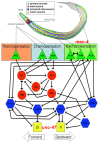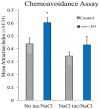Demonstrating Connections Between Neuron Signaling and Behavior using C. elegans Learning Assays and Optogenetics in a Laboratory Class
- PMID: 30254536
- PMCID: PMC6153016
Demonstrating Connections Between Neuron Signaling and Behavior using C. elegans Learning Assays and Optogenetics in a Laboratory Class
Abstract
Due to its well-described neural circuitry and identified connectome, the Caenorhabditis elegans model is well-suited for demonstrating connections between neuron signaling and behavioral outcome. In the 2017 FUN workshop at Dominican University, three behavior-based techniques were introduced for their ease of introduction to students, the flexible data collection options they offer and the inexpensive cost to implement in an education setting. These behavioral assays were adapted to address some of the challenges of performing C. elegans behavior experiments in lab classes and included: an associative chemosensory avoidance task to examine behavior of groups of worms, a mechanosensory task to observe individual worm behavior and an optogenetics assay to directly manipulate neuron signaling and simultaneously observe resultant behavior. Methods for these assays as well as example data collected by undergraduate students in a lab class are provided. FUN Workshop feedback and assessment indicate these assays were well-received and overall seen as valuable for introducing neuroscience and behavior to undergraduates in a lab class.
Keywords: associative chemotaxis; biogenic amines; channelrhodopsin (ChR2); gustatory signaling; habituation; head touch; learning; mechanosensory.
Figures







Similar articles
-
Using Optogenetics to Understand Neuronal Mechanisms Underlying Behavior in C. elegans.J Undergrad Neurosci Educ. 2018 Jun 15;16(2):A152-A158. eCollection 2018 Spring. J Undergrad Neurosci Educ. 2018. PMID: 30057497 Free PMC article.
-
Dual Color Neural Activation and Behavior Control with Chrimson and CoChR in Caenorhabditis elegans.Genetics. 2015 Aug;200(4):1029-34. doi: 10.1534/genetics.115.177956. Epub 2015 May 28. Genetics. 2015. PMID: 26022242 Free PMC article.
-
C. elegans positive butanone learning, short-term, and long-term associative memory assays.J Vis Exp. 2011 Mar 11;(49):2490. doi: 10.3791/2490. J Vis Exp. 2011. PMID: 21445035 Free PMC article.
-
Beyond the response-High throughput behavioral analyses to link genome to phenome in Caenorhabditis elegans.Genes Brain Behav. 2018 Mar;17(3):e12437. doi: 10.1111/gbb.12437. Epub 2018 Jan 17. Genes Brain Behav. 2018. PMID: 29124896 Review.
-
Illuminating neural circuits and behaviour in Caenorhabditis elegans with optogenetics.Philos Trans R Soc Lond B Biol Sci. 2015 Sep 19;370(1677):20140212. doi: 10.1098/rstb.2014.0212. Philos Trans R Soc Lond B Biol Sci. 2015. PMID: 26240427 Free PMC article. Review.
Cited by
-
Classroom-Based Research Experiences to Support Underserved STEM Student Success: From Introductory Inquiry to Optogenetics in the Embryonic Chicken.J Undergrad Neurosci Educ. 2018 Dec 15;17(1):A97-A110. eCollection 2018 Fall. J Undergrad Neurosci Educ. 2018. PMID: 30618506 Free PMC article.
-
A Versatile Semester-Long Course-Based Undergraduate Research Experience using Optogenetics and RNAi to Identify Genes Important for Synapse Function.J Undergrad Neurosci Educ. 2023 Dec 17;22(1):A1-A13. doi: 10.59390/XZQL5300. eCollection 2023 Fall. J Undergrad Neurosci Educ. 2023. PMID: 38322408 Free PMC article.
-
Reducing the Cost of Electrophysiology in the Teaching Laboratory.J Undergrad Neurosci Educ. 2018 Sep 15;16(3):A277-A281. eCollection 2018 Summer. J Undergrad Neurosci Educ. 2018. PMID: 30254544 Free PMC article.
-
Probing Synaptic Transmission and Behavior in Drosophila with Optogenetics: A Laboratory Exercise.J Undergrad Neurosci Educ. 2018 Sep 15;16(3):A289-A295. eCollection 2018 Summer. J Undergrad Neurosci Educ. 2018. PMID: 30254546 Free PMC article.
References
-
- Ahringer J. WormBook, editor. The C. elegans Research Community. WormBook; Reverse genetics (April 6, 2006) http://www.wormbook.org. - DOI
-
- C. elegans Sequencing Consortium. Genome sequence of the nematode C. elegans: a platform for investigating biology. Science. 1998;282:2012–2018. - PubMed
LinkOut - more resources
Full Text Sources
Miscellaneous
